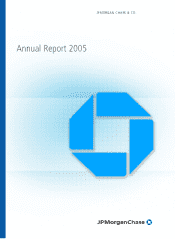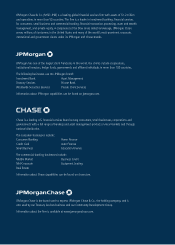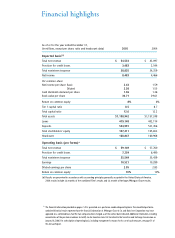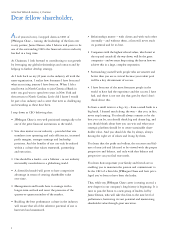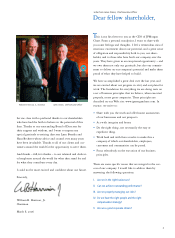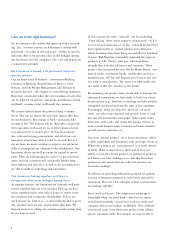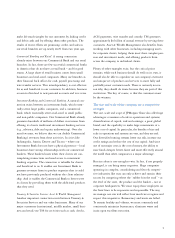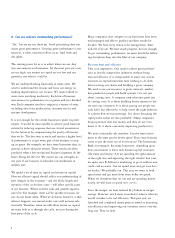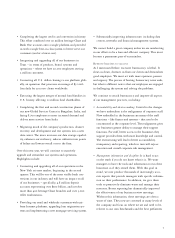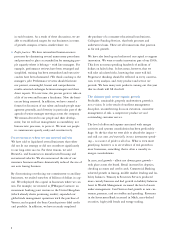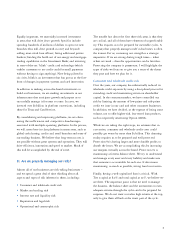JP Morgan Chase 2005 Annual Report Download - page 7
Download and view the complete annual report
Please find page 7 of the 2005 JP Morgan Chase annual report below. You can navigate through the pages in the report by either clicking on the pages listed below, or by using the keyword search tool below to find specific information within the annual report.
5
make life much simpler for our customers by linking credit
and debit cards and by offering them other products. The
results of recent efforts are promising: credit card sales in
our retail branches are up nearly %from two years ago.
Commercial Banking and Retail. A strong connection
already exists between our Commercial Bank and our retail
branches. In fact, there are few successful commercial banks
in America that do not have a retail bank – and for good
reason. A large share of retail business comes from small
businesses and mid-sized companies. Many use branches as
their financial back offices for cash, payroll processing and
wire transfer services. This interdependency is cost effective
for us and beneficial to our customers. In addition, business
accounts often lead to new personal accounts and vice versa.
Investment Banking and Commercial Banking. Anatural con-
nection exists between an investment bank, which essen-
tially serves large public companies, and a commercial
bank, which essentially serves mid-sized to small public
and non-public companies. Our Commercial Bank already
generates hundreds of millions of dollars in revenues from
offering its clients traditional investment banking services
(e.g., advisory, debt and equity underwriting). Over the
next few years, we believe that we can double Commercial
Banking’s revenues from these activities. In cities like
Indianapolis, Austin, Denver and Tucson – where our
Investment Bank does not have a physical presence – local
businesses have strong relationships with our commercial
bankers. These bankers know when their clients are con-
templating transactions and need access to investment
banking expertise. The connection is valuable for clients
and beneficial to us. It enables our Investment Bank to
generate revenues from its product expertise that it could
not have previously produced without the client relation-
ship. And it enables the Commercial Bank to better serve
its clients by providing them with the additional products
that they need.
Treasury & Securities Services; Asset & Wealth Management.
Another important connection exists between Treasury &
Securities Services and our other businesses. Many of our
major customers (institutional, middle market, small busi-
ness and retail) use TSS for activities such as cash, checks,
ACH payments, wire transfer and custody. TSS generates
approximately $billion of annual revenue by serving these
customers. Asset & Wealth Management also benefits from
working with other businesses, including managing assets
for corporate clients, helping them meet their complex pen-
sion and investment needs, and offering products from
across the company to individual clients.
Plenty of other examples exist, but the critical point
remains: while each business should do well on its own, it
should also be able to capitalize on our company’s extensive
and unique set of products and services to more fully and
profitably meet customer needs. There is certainly no rea-
son why they should do worse because they are part of this
institution. The key,of course, is that the customers must
be the winners.
The size and scale of the company are a competitive
strength
The size, scale and scope of JPMorgan Chase also offer huge
advantages: economies of scale in operations and systems;
diversification of capital, risk and earnings; a great global
brand; and the capability to make large investments at a
lower cost of capital. In particular, the benefits of size and
scale in operations and systems are vast, and they are real.
Our diversified earning streams lower our risk, increase our
credit ratings and reduce the cost of our capital. And since
one of our major costs is the cost of money, the ability to
raise funds cheaper, better, faster and more effectively around
the world than other companies is a major advantage.
But size alone is not enough to win. In fact, if not properly
managed, it can bring many negatives. Huge companies
operating in complex, consolidating and fiercely competi-
tive industries like ours can only achieve and sustain their
success by competing where the “rubber hits the road” –at
the level of the store, the product and the banker – not at
corporate headquarters. We must equip those employees on
the front lines to be responsive and responsible. The way
we manage our size will reflect how much we recognize and
respect this imperative. Bureaucracy and waste are lethal.
To remain healthy and vibrant, we must constantly and
consistently minimize bureaucracy, eliminate waste and
insist upon excellent execution.

